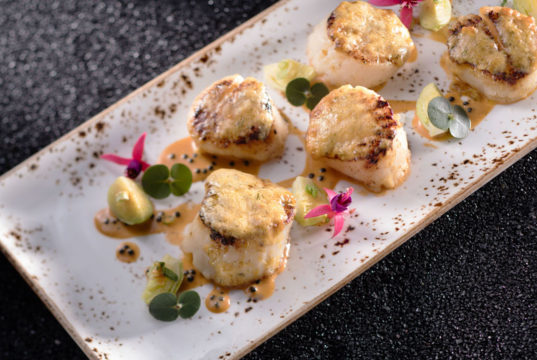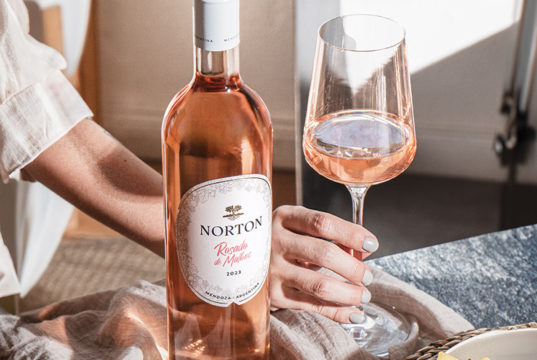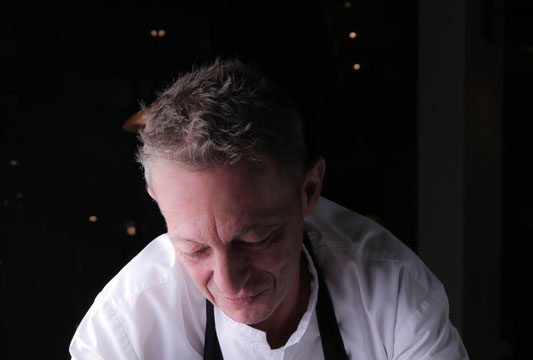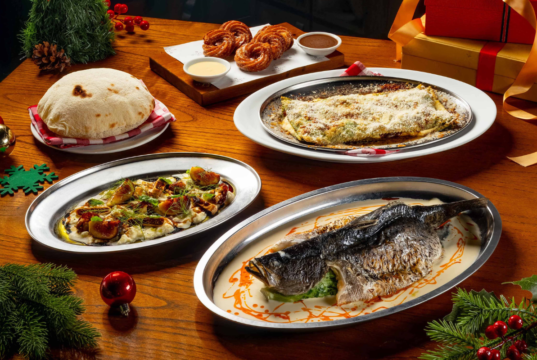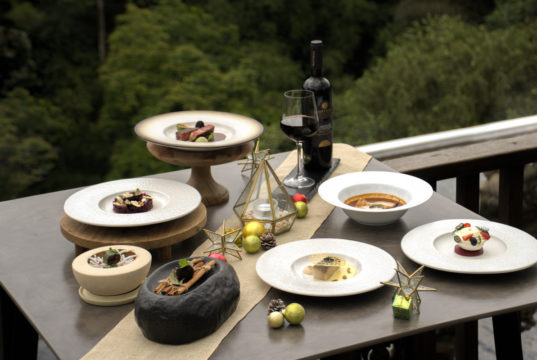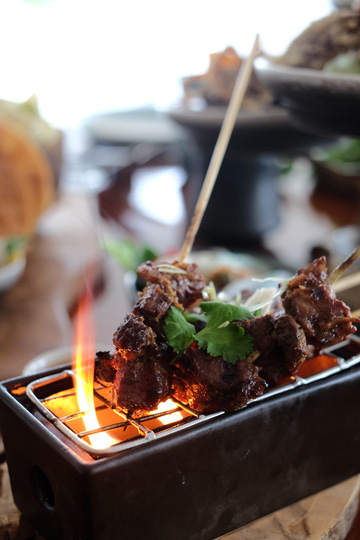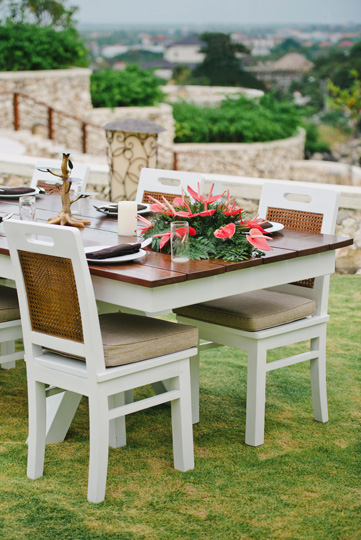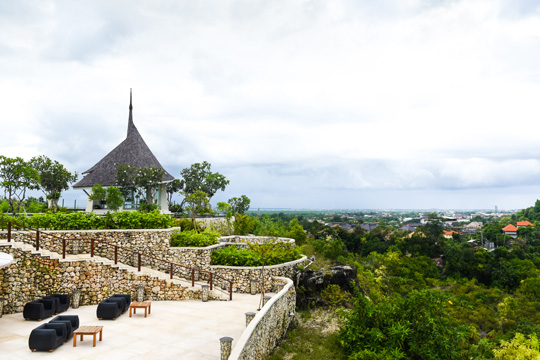Ensconced on the rocky hills of Jimbaran, OPIA, Dining Destination serves age-old Asian dishes in a fresh, new way, complete with a convivial vibe that makes guests feel at home.
—
Tucked away in one of the inconspicuous corners of Jimbaran, OPIA, Dining Destination is a nice surprise – a hidden gem uncovered when one least expects it. The facade of the restaurant – stone walls, a wooden entrance, and a simple sign bearing the moniker – doesn’t give away any of the wonders inside. As guests walk in, they are welcomed by a picturesque white interior palette , a nice blank canvas for the following jaw-dropping vista of the surrounding neighbourhood. From an elevated vantage point, patrons can really bask in the dramatic views of high stony cliffs and the last hues of the sunset before they are replaced by the lights of the Jimbaran skyline.
The tranquil white setting also makes a good contrast to the vibrant dishes served here, courtesy of Executive Chef Nicolas Lazzaroni. Nicolas made it clear from the start, OPIA serves Asian-inspired sharing plates served family style. Eager diners are expected to be curious – to want to try as many varieties as possible. That’s why all 22 dishes (plus five desserts) are equally priced, Nicolas explained, “I don’t want people to be constricted on what they order based on the price.”
Those with a discerning eye will be able to see how every little detail at OPIA has been well thought out. Nicolas said that the natural touch and elements gracing the tables – marble coasters, wooden boards used as plates, and the roughly polished ceramic glasses – are homage to mother nature. Each table’s pièce de résistance is the tree-like centrepiece, which also doubles as the plate holder. “By placing the plates at eye level, guests are made to look at the people they’re here with, as well as the dishes, and I hope that will invoke interaction between guests as much as possible,” said Nicolas.
Having said that, there’s more to OPIA than meets the eye. The fare, though based on traditional Asian recipes, is taken to a new modern level that is sophisticated, yet casual and relevant at the same time. With dishes like the Thai-influenced tropical coconut king prawn salad, and the Chinese-inspired crispy duck that has been twice cooked in palm reduction and served with candied pineapple, Nicolas succeeds in creating something that strikes the right chord with long-time Asian food enthusiasts, while also giving a friendly introduction to those who aren’t too familiar with the cuisine. The crispy soft shell crab mango salad and the soy-braised Balinese black pork belly with five spice crackling steal the spotlight with a mélange of tastes and textures.
OPIA is one of the rare gems that focus on different elements – food, service, and ambience – rather than excelling in just one of them. Nicolas doesn’t want the restaurant to be known as a place that has one particular signature dish – he wants the experience to be the signature, and with the evident excellence of the food and the obvious unparalleled atmosphere, that shouldn’t be hard to achieve.
Nicolas Lazzaroni’s journey in the culinary world started with a humble beginning that opened his eyes to many other aspects of the hospitality industry other than just cooking. Now, as the executive chef of OPIA, Dining Destination, Nicolas – a person of many passions – uses his knack for art and construction to create tasteful Asian dishes. We had the opportunity to catch up with him and see what makes him tick.
E: In your opinion, what makes the cuisine of OPIA, Dining Destination special?
A: I feel that the cuisine at OPIA, Dining Destination is a part of a special concept, and is a part of a whole dining experience. Respecting that is what I feel makes the cuisine special. The cuisine is designed to invoke friendly interaction between guests and their table, break down barriers of what to order, and ensure that no matter the palate there will be highlighted dishes for each individual.
E: Where do you find inspirations for new creations?
A: Inspirations for new dishes come from day-to-day life. Much like an artist, without planning or intention, certain things trigger a new idea, be it seeing special or beautiful produce, a nice shape, hearing a song, a passing conversation… After a thought has been triggered, it’s a very pleasing feeling to re-imagine it as a new menu item.
E: Can you describe some of the special aspects of your kitchen?
A: Without a doubt one of the most special aspects of my kitchen is the team inside. I love to see them grow and support each other day to day. Another aspect of my kitchen is the combination of traditional and modern cooking equipment. I feel that Asian food needs to have its base recipe and cooking techniques respected, otherwise a lot of needed integrity is lost. In the same way, there are some elements that are executed utilising modern cooking techniques to ensure that proteins and plating techniques are upholding the contemporary culinary bar.
E: Which dish at the restaurant is your favourite? Can you provide us some background on the dish’s beginnings and preparation?
A: A dish that has been a favourite from day one at OPIA is our caramelised soy braised pork belly and five spice crackling. The dish is a great example of the above statement and indeed holds tight to the base of a Chinese soy braised pork dish, but has incorporated new age cooking techniques, such as sous vide, dehydration and dusting.
www.opiabali.com
—
Caramelised Soy Braised Pork Belly
Ingredients Soy Braised Pork Belly
• ½ loaf pork belly (skin separated and salted to be cooked separately)
• 2l master stock
• 250g Chinese cooking wine
• 50g dried shiitake mushroom
• 200g coriander root
• 20g ginger
• ¼ cinnamon stick
• 40g honey
• 40g soy sauce
• 40g sweet soy
• 5g fennel seed
• 5pcs dried orange zest
Master stock
• 4l water
• 50g ginger (cleaned and sliced)
• 100g brown onion (cleaned and sliced)
• 1 cinnamon stick
• 10g fennel seed
• 10g star anise
• 4pcs dried orange skin
• 40g coriander root (cleaned and sliced)
• 300g Chinese cooking wine
• 100g sweet soy
• 100g light soy sauce
• 100g honey
Method Pork belly
1. Simmer all aromatics in the master stock for 15 minutes.
2. Add the pork belly and press with something to make sure the belly is submerged in the master stock.
3. Simmer gently for two hours until meat is tender but not dry.
4. Take out the pork belly and press between two baking trays overnight.
5. With a sharp knife, cut the chilled pork belly into portions.
Skin
1. Scrub the skin with salt and fennel seeds.
2. Leave the salt for a minimum of two hours, then rinse and pat dry.
3. Use a silicon mat and press the pork skin flat and roast for 30 minutes at 190 degrees Celsius.
4. After the skin has had its initial cooking, slice into the desired size and fry in hot oil when ready to serve.
Putting The Dish Together
1. Take two portions of pork belly and heat in Teflon with 100ml of the remaining poaching liquid.
2. Simmer until the liquid starts to caramelise, then move the pork around to collect all the caramel sauce.
3. After the pork belly has obtained some caramelised colour, take it out and place it on a plate.
4. In the same Teflon, heat 50ml more of the poaching liquid and pour over the pork belly.Add the pork skin to the frying oil and fry until bubbled and crispy.
5. Take from the oil, place on absorbent paper and sprinkle with salt.
6. Place crackling on the plated pork belly and garnish with coriander.








